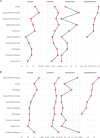Psychological Distress, Resources, and Coping Strategies Among Evacuees and Non-Evacuees From an Armed Conflict Zone: A Network Analysis
- PMID: 39698890
- PMCID: PMC11656507
- DOI: 10.1002/smi.3525
Psychological Distress, Resources, and Coping Strategies Among Evacuees and Non-Evacuees From an Armed Conflict Zone: A Network Analysis
Abstract
This study focuses on two groups: evacuees from Israel's southern and northern frontline communities following the October 7th Hamas attack, and individuals from regions not directly threatened. Using network analysis, we identified key associations and central nodes related to stress indicators (i.e., exposure to traumatic life events, physical health-related quality of life, anxiety, and depression) as well as personal resources (i.e., self-mastery and meaning in life), and coping strategies. The study included 221 evacuees and 145 non-evacuees (controls), recruited via iPanel, Israel's leading online research panel. Participants completed standardised self-report questionnaires. Evacuees exhibited higher levels of anxiety, depression, and traumatic life events, than did controls. Additionally, evacuees showed higher levels of problem-focused coping and a greater sense of meaning in life, along with lower physical health-related quality of life. Network analysis revealed that both groups had four sub-networks: 'personal state', 'psychological distress', 'resources', and 'coping'. However, the sub-networks' composition varied. Both groups shared similar sub-networks for 'coping' and 'personal state', but differed in 'psychological distress' and 'resources'. For the controls, dysfunctional coping strategies were part of 'psychological distress', whereas for evacuees, they were included in 'resources'. Additionally, meaning in life was more central among the controls, influencing the interaction between coping mechanisms, personal states, and psychological distress. For evacuees, physical health-related quality of life was more closely associated with the absence of negative factors-(i.e., anxiety, depression, traumatic experiences, and lower self-mastery)-rather than the presence of adaptive coping strategies and meaning in life. These differences highlight the vulnerability of evacuees and the central role of personal resources. Targeted interventions that foster resources such as self-mastery and meaning in life are vital for coping with the psychological distress associated with forced displacement.
Keywords: armed conflict zone; coping strategies; evacuees/displaced persons; network analysis; psychological distress; resources.
© 2024 The Author(s). Stress and Health published by John Wiley & Sons Ltd.
Conflict of interest statement
The authors declare no conflicts of interest.
Figures



Similar articles
-
Early Evidence on the Emotional Distress of Civilians, Including Evacuees, During a Recent Conflict.Int J Psychol. 2025 Jun;60(3):e70048. doi: 10.1002/ijop.70048. Int J Psychol. 2025. PMID: 40325823 Free PMC article.
-
Coping, meaning in life, and quality of life during ongoing conflict: insights from Israeli populations.Isr J Health Policy Res. 2025 Jan 8;14(1):1. doi: 10.1186/s13584-024-00665-1. Isr J Health Policy Res. 2025. PMID: 39780281 Free PMC article.
-
Resilience and coping during protracted conflict: a comparative analysis of general and evacuees populations.Isr J Health Policy Res. 2024 Oct 3;13(1):56. doi: 10.1186/s13584-024-00642-8. Isr J Health Policy Res. 2024. PMID: 39358809 Free PMC article.
-
The relationship between coping style and psychological distress in people with head and neck cancer: A systematic review.Psychooncology. 2018 Mar;27(3):734-747. doi: 10.1002/pon.4509. Epub 2017 Aug 25. Psychooncology. 2018. PMID: 28748624
-
Psychological distress among Israelis during crisis: A comparison between COVID-19 and the Iron Swords War.Psychiatry Res. 2025 Jun;348:116491. doi: 10.1016/j.psychres.2025.116491. Epub 2025 Apr 10. Psychiatry Res. 2025. PMID: 40245664 Review.
Cited by
-
Early Evidence on the Emotional Distress of Civilians, Including Evacuees, During a Recent Conflict.Int J Psychol. 2025 Jun;60(3):e70048. doi: 10.1002/ijop.70048. Int J Psychol. 2025. PMID: 40325823 Free PMC article.
References
-
- Al Ibraheem, B. , Kira I. A., Aljakoub J., and Al Ibraheem A.. 2017. “The Health Effect of the Syrian Conflict on IDPs and Refugees.” Peace and Conflict: Journal of Peace Psychology 23, no. 2: 140–152. 10.1037/pac0000247. - DOI
-
- Alobo, E. , and Obaji S.. 2016. “Internal Displacement in Nigeria and the Case for Human Rights Protection of Displaced Persons.” Journal of Law, Policy and Globalization 51: 26–33.
-
- Biggs, A. , Brough P., and Drummond S.. 2017. “Lazarus and Folkman's Psychological Stress and Coping Theory.” In The Handbook of Stress and Health: A Guide to Research and Practice, edited by Cooper C. L. and Quick J. C., 349–364. Hoboken, NJ: John Wiley & Sons Ltd. 10.1002/9781118993811. - DOI
MeSH terms
LinkOut - more resources
Full Text Sources

